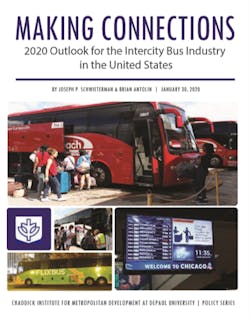Intercity Bus Industry Reaches An Important Milestone: New DePaul Study
America’s intercity bus industry has reached a milestone: for the first time in its history, the industry has three carriers with large-scale route networks that cover larger parts of both the eastern and western halves of its U.S. mainland. These three—Greyhound, Megabus and the newcomer Flixbus—all made notable strategic moves last year. Flixbus has been in the headlines for the breakneck expansion, putting it now in 22 states.
These findings and others are centerpieces of DePaul University’s Making Connections: 2020 Outlook for the Intercity Bus Industry in the United States, a report that shows an industry in the midst of competitive and strategic adjustment.
Among the big stories last year was the announcement by Scotland-based FirstGroup in May that it is looking to sell Greyhound Lines, a move comes at a time of considerable demand variability. Revenues rose last spring and summer due to a surge in immigrant riders but subsided during autumn. The sale, in FirstGroup’s view, could bring renewed opportunity to improve the legacy brand’s marketing prowess and to strengthen greyhound.com.
Stagecoach’s Megabus unit and the rest of the Scotland-based company’s U.S. operations, meanwhile, were formally acquired by California-based Variant Equity. In June, Megabus rolled out a Partners Program that lays groundwork for more contracting with other bus lines on the megabus.com platform. Essentially an “open call” to charter bus operators, it offers companies who provide scheduled services sold under the megabus.com umbrella access to extensive marketing, distribution and technical services. While most of the Megabus network is still operated by Coach USA units, the move allows the carrier to expand without the burden associated with directly operating buses. In response, Windstar assumed operation of Megabus’ Los Angeles-Las Vegas route while Empire Coach Lines began operating Megabus’ entire Florida operations
Further expansion by Germany-based Flixbus, which began U.S. service in Spring 2018, seems destined to make it more prevalent from coast to coast. Last year’s brought it to the Northeast, Southeast, Pacific Northwest, and Texas. New routes to more Midwestern and Southeastern cities may be in the offing. Maintaining service standards while growing so rapidly, though, may be challenging.
Another cautionary note is that rising automobile ownership and persistently low gasoline prices are putting pressure to innovate in rural regions, where ridership is generally flat. More state governments, in response, may seek to create branded networks of intercity bus routes like Colorado’s Bustang and the Virginia Breeze. The evidence is compelling that these systems can be both cost effective and attractive to broad demographic segments. Some of these services are funded by funds provided by the U.S. Department of Transportation to improve rural transit options.
The Chaddick Institute is hosting a free hour-long webinar on Making Connections on Friday, February 14 at noon Central time (10 a.m. Pacific). The register or reach the study team, email [email protected].




